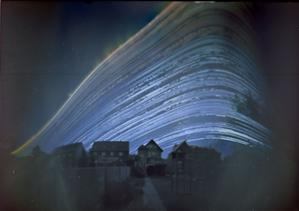Glossarbegriffe: Tagundnachtgleiche
Description: Das wahre Äquinoktium ist der Zeitpunkt, an dem die Sonne auf ihrer jährlichen Reise durch die Ekliptik den Himmelsäquator überquert. Das Wort leitet sich vom lateinischen aequinoctium ab, mit aequus (gleich) und nox (Genitiv noctis) (Nacht). Am Tag der Tagundnachtgleiche (auch Äquinoktium genannt) sind die Tages- und Nachtzeiten auf der ganzen Erde ungefähr gleich lang, nicht nur in Äquatornähe. Für einen Beobachter auf der Erde geht die Sonne genau in der östlichen Himmelsrichtung auf, bewegt sich an diesem Tag scheinbar entlang der Linie des Himmelsäquators und geht genau im Westen unter. Es gibt zwei Tagundnachtgleichen pro Jahr, eine um den 20. März und eine um den 23. September. Die März-Tagundnachtgleiche zeigt den scheinbaren Durchgang der Sonne in Richtung der nördlichen Hemisphäre an, die September-Tagundnachtgleiche den scheinbaren Durchgang der Sonne in Richtung Süden.
Zugehörige Glossarbegriffe:
See this term in other languages
Term and definition status: The original definition of this term in English have been approved by a research astronomer and a teacher The translation of this term and its definition is still awaiting approval
The OAE Multilingual Glossary is a project of the IAU Office of Astronomy for Education (OAE) in collaboration with the IAU Office of Astronomy Outreach (OAO). The terms and definitions were chosen, written and reviewed by a collective effort from the OAE, the OAE Centers and Nodes, the OAE National Astronomy Education Coordinators (NAECs) and other volunteers. You can find a full list of credits here. All glossary terms and their definitions are released under a Creative Commons CC BY-4.0 license and should be credited to "IAU OAE".
Zugehörige Medien
Where the Sun Sets Every Month
Bildnachweis: John Paul Pile/IAU OAE (CC BY 4.0)
License: CC-BY-4.0 Creative Commons Namensnennung 4.0 International (CC BY 4.0) icons
The Path of the Sun
Bildnachweis: Frank Niessen/IAU OAE (CC BY 4.0)
License: CC-BY-4.0 Creative Commons Namensnennung 4.0 International (CC BY 4.0) icons
Sonnenwende und Tagundnachtgleiche
Bildnachweis: Tunç Tezel/IAU OAE (CC BY 4.0)
License: CC-BY-4.0 Creative Commons Namensnennung 4.0 International (CC BY 4.0) icons
Occasive Amplitude
Bildnachweis: Marcella Giulia Pace/IAU OAE (CC BY 4.0)
License: CC-BY-4.0 Creative Commons Namensnennung 4.0 International (CC BY 4.0) icons












